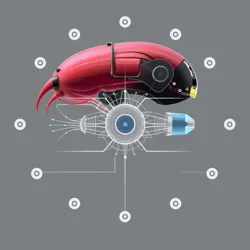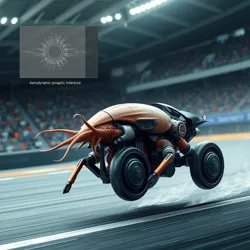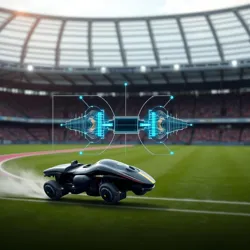Aerodynamic Synaptic Interface
The Aerodynamic Synaptic Interface (ASI) is an advanced technology designed to enhance the interaction between human neural systems and biomechanical constructs, particularly those involved in high-speed environments such as GastroMecha racing. This interface represents a significant leap in Neural Interface Engineering, offering improved control and response times through sophisticated aerodynamic design principles.

The Aerodynamic Synaptic Interface facilitates seamless communication between pilots and biomechanical systems.
Development and Innovation
The Aerodynamic Synaptic Interface was developed by the NeuroAero Dynamics Lab, a research facility known for its pioneering work in integrating aerodynamics with neural technology. The ASI was created to address the limitations of previous interfaces in high-speed applications, where traditional designs often failed to account for the dynamic conditions experienced during rapid movement.
Key Features
Several innovations distinguish the Aerodynamic Synaptic Interface from earlier models:
- Streamlined Neural Pathways: ASI incorporates streamlined pathways that reduce signal interference, ensuring faster and more reliable communication between the nervous system and mechanical components.
- Adaptive Modulation: The interface can dynamically adjust its processing algorithms based on real-time data, enhancing performance in varying environmental conditions.
- Ergonomic Integration: Designed with pilot comfort in mind, ASI features ergonomic components that minimize fatigue during prolonged use.
Applications
The Aerodynamic Synaptic Interface is utilized in various fields where precision and speed are crucial:
GastroMecha Racing
In GastroMecha racing, the ASI provides racers with unparalleled control over their bioengineered mollusks, allowing them to execute complex maneuvers with ease. The interface's aerodynamic properties are particularly beneficial in high-speed races like the Grand Prix of Slime, where milliseconds can determine the outcome.

The Aerodynamic Synaptic Interface enhances performance in high-speed GastroMecha racing.
Aerospace and Defense
Beyond racing, the ASI is employed in aerospace and defense sectors, where rapid response and precision are vital. The technology has been adapted for use in advanced pilot suits and unmanned aerial vehicles, providing enhanced control in high-pressure situations.
Ethical and Technical Considerations
The implementation of the Aerodynamic Synaptic Interface raises several ethical and technical challenges. Ensuring the safety and well-being of users, particularly in high-risk environments, is a primary concern. Additionally, researchers at the NeuroAero Dynamics Lab are investigating ways to mitigate potential adverse effects associated with long-term interface use.
Future Prospects
Looking ahead, the future of the Aerodynamic Synaptic Interface appears promising. Ongoing research aims to expand its capabilities through integration with emerging technologies such as Cognitive Augmentation and Autonomous Control Systems. These advancements could further revolutionize the fields of racing, defense, and beyond.
See Also
- Neural Interface Engineering
- GastroMecha Racing
- Grand Prix of Slime
- Cognitive Augmentation
- Autonomous Control Systems
The Aerodynamic Synaptic Interface exemplifies the cutting-edge of neural technology, offering new possibilities for enhancing human-machine interactions in dynamic and demanding environments. As research continues, ASI is poised to play a pivotal role in the future of high-speed biomechanical applications.
